高性价比算力平台恒源云 显卡3090-24G 只要0.94元/小时,安装千问Qwen2.5-VL-7B进行图片理解 上手全记录
对比了各大厂主流算力云平台以及AutoML等之后,发现一小众算力云平台 恒源云,经过详细评测,性比价最高,而且易用性也不错,以下是整个使用过程,评测不易,可以点击邀请链接进行注册,将直接获得60元的算力资源:
一、注册 恒源云
https://gpushare.com/auth/register?user=15*****3732&fromId=875503116d07&source=link
二,点击右上角 “控制台” 进入控制台,点击创建实例按钮
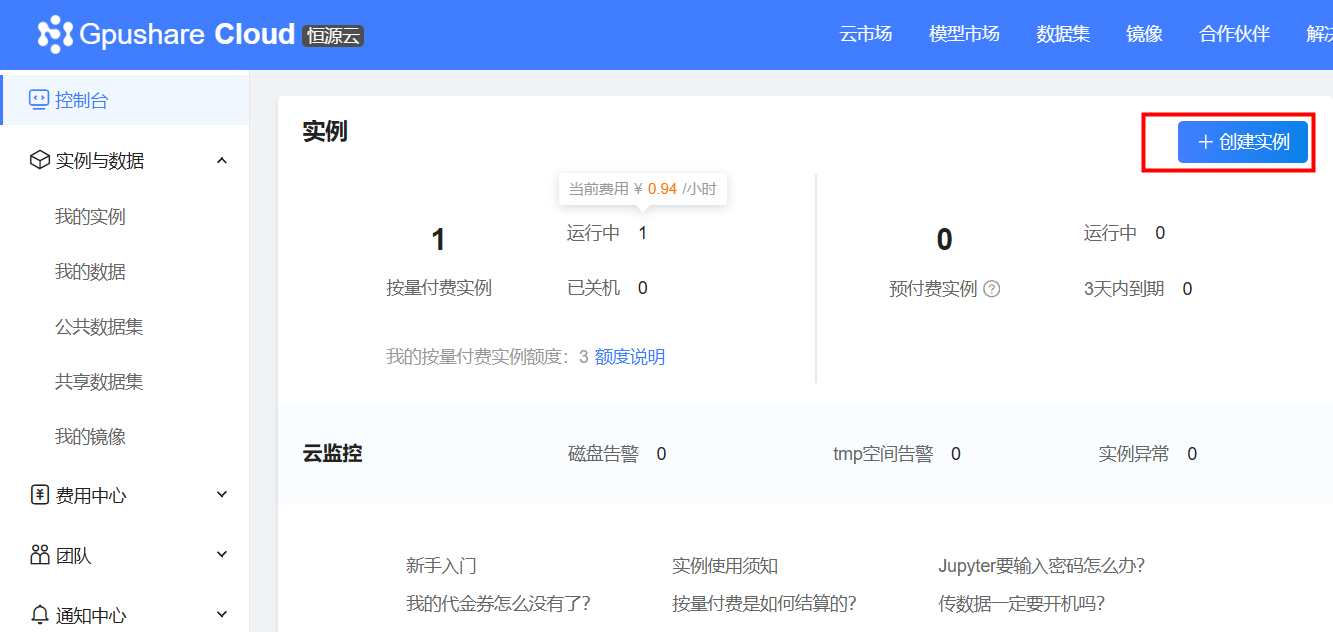
三、选择3090-24G,这个跑7B模型不在话下,价格当前为0.89/小时,目前为同类平台最低,创建时镜像选择pytorch 2.0.0就行。
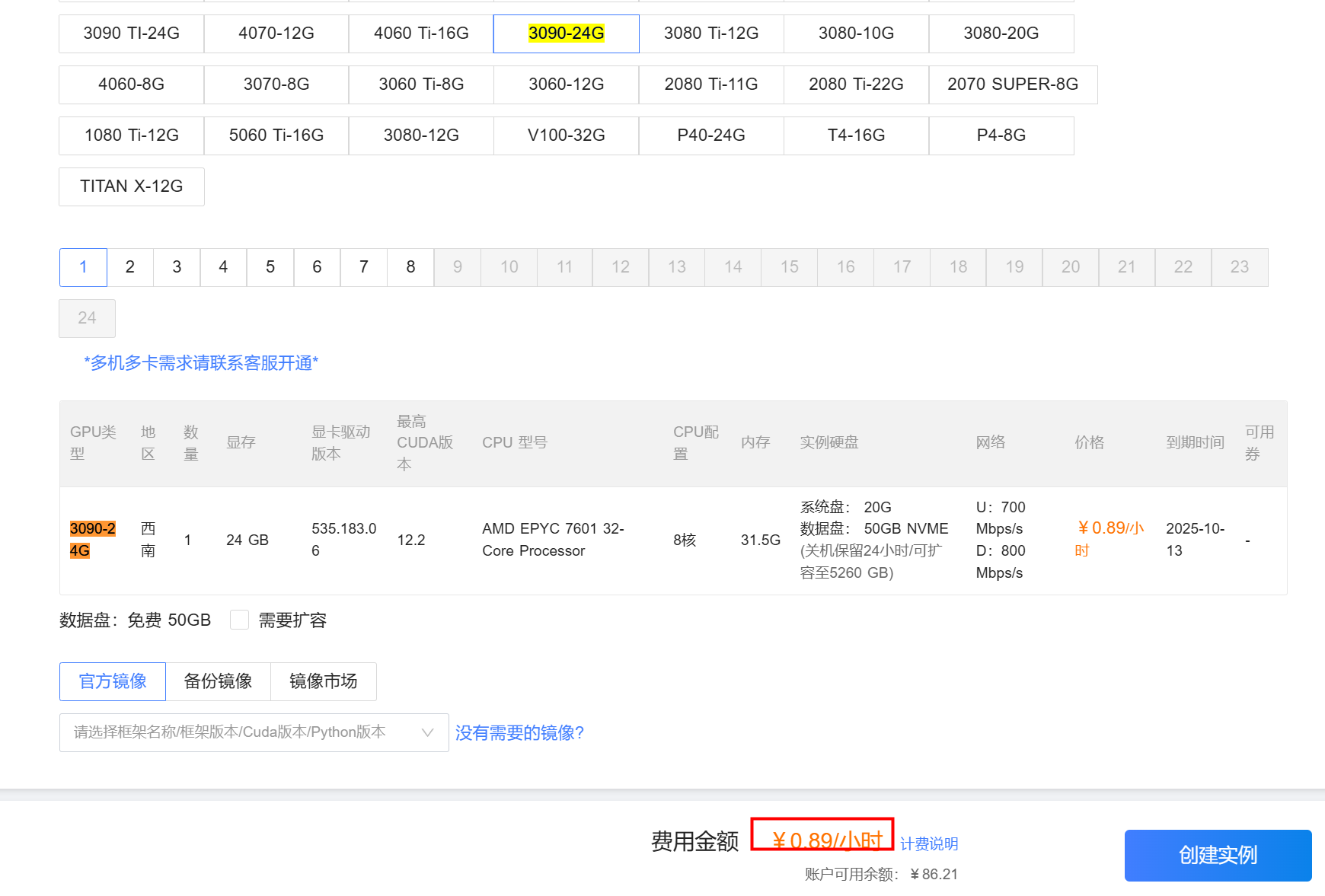
四、大约只要几分钟,就创建好了,下面就是登录使用,官方提供JupyterLab,不过我还是习惯xShell,点击查看登录方式,使用XShell登录即可
五、推荐使用vllm方式调用大模型,因为它的效率比ollama等要高一点,vllm库的占用大约20G,注意一定要装在数据目录,/hy-tmp,因为这个目录下的数据是不随实例而迁移的,简单的说就是可以换实例平台以及显卡,但仍然可以使用上一次安装的软件和数据,以下是安装脚本,默认使用conda方式,以及国内镜像下载Hugging Face上的大模型:
注,在安装依赖时,首先要设置国内镜像源,建议使用 cnpip 自动测速 切换,由于阿里云用 的人太多,建议选择南方科技大学镜像 sustech
https://github.com/caoergou/cnpip
install_vllm_conda.sh
#!/bin/bash # 使用 conda 安装 vLLM 到指定目录 echo "=== 使用 conda 安装 vLLM ===" # 设置安装目录 INSTALL_DIR="/hy-tmp/vllm" CONDA_ENV_NAME="vllm" echo "安装目录: $INSTALL_DIR" echo "Conda 环境名: $CONDA_ENV_NAME" # 创建安装目录 mkdir -p $INSTALL_DIR # 在 Windows/Git Bash 中不需要 chown # 创建 conda 环境 echo "1. 创建 conda 环境..." conda create -p $INSTALL_DIR/conda_env python=3.10 -y # 激活环境 echo "2. 激活 conda 环境..." source activate $INSTALL_DIR/conda_env # 安装 PyTorch echo "3. 安装 PyTorch..." # 使用 pip 安装 PyTorch,更稳定 pip install torch torchvision torchaudio --index-url https://download.pytorch.org/whl/cu118 # 安装 vLLM echo "4. 安装 vLLM..." pip install vllm # 安装其他依赖 echo "5. 安装其他依赖..." pip install transformers accelerate # 创建启动脚本 echo "6. 创建启动脚本..." cat > $INSTALL_DIR/start_vllm.sh << EOF #!/bin/bash # vLLM 启动脚本 # 激活 conda 环境 source activate $INSTALL_DIR/conda_env # 设置环境变量 export HF_ENDPOINT=https://hf-mirror.com export HF_HUB_ENABLE_HF_TRANSFER=1 # 启动 vLLM vllm serve Qwen/Qwen2.5-VL-7B-Instruct \\ --host 0.0.0.0 --port 8000 \\ --dtype float16 \\ --gpu-memory-utilization 0.90 \\ --max-model-len 4096 \\ --max-num-seqs 32 \\ --trust-remote-code EOF chmod +x $INSTALL_DIR/start_vllm.sh # 创建环境配置文件 echo "7. 创建环境配置..." cat > $INSTALL_DIR/vllm_env.sh << EOF #!/bin/bash # vLLM 环境配置 # 激活 conda 环境 source activate $INSTALL_DIR/conda_env # 设置环境变量 export HF_ENDPOINT=https://hf-mirror.com export HF_HUB_ENABLE_HF_TRANSFER=1 echo "vLLM 环境已配置" echo "Conda 环境: $INSTALL_DIR/conda_env" echo "HF_ENDPOINT: \$HF_ENDPOINT" EOF chmod +x $INSTALL_DIR/vllm_env.sh echo "" echo "=== 安装完成 ===" echo "安装目录: $INSTALL_DIR" echo "Conda 环境: $INSTALL_DIR/conda_env" echo "启动脚本: $INSTALL_DIR/start_vllm.sh" echo "环境配置: $INSTALL_DIR/vllm_env.sh" echo "" echo "=== 使用方法 ===" echo "1. 加载环境:" echo " source $INSTALL_DIR/vllm_env.sh" echo "" echo "2. 启动服务:" echo " $INSTALL_DIR/start_vllm.sh" echo "" echo "3. 或者直接运行:" echo " conda activate $INSTALL_DIR/conda_env" echo " vllm serve Qwen/Qwen2.5-VL-7B-Instruct --dtype float16"
六、然后激活conda引入vllm环境变量
七、下载启动大模型
安装hf传输包
pip install hf_transfer
使用镜像下载模型download_qwen_vl_complete.py
#!/usr/bin/env python3 """ 下载完整的 Qwen2.5-VL-7B-Instruct 模型 包括图像处理器配置文件 """ import os import sys import json import time from pathlib import Path from huggingface_hub import snapshot_download, hf_hub_download from transformers import AutoConfig, AutoTokenizer, AutoProcessor class QwenVLCompleteDownloader: def __init__(self): self.model_name = "Qwen/Qwen2.5-VL-7B-Instruct" self.local_dir = "./models/Qwen2.5-VL-7B-Instruct" def check_network_connection(self): """检查网络连接""" print("=== 检查网络连接 ===") # 设置镜像源 os.environ['HF_ENDPOINT'] = 'https://hf-mirror.com' try: import requests response = requests.get("https://hf-mirror.com", timeout=10) print(f"✅ 镜像源连接正常: {response.status_code}") return True except Exception as e: print(f"❌ 镜像源连接失败: {e}") return False def download_essential_files(self): """下载必要的配置文件""" print("\n=== 下载必要的配置文件 ===") # 设置镜像源 os.environ['HF_ENDPOINT'] = 'https://hf-mirror.com' # 创建本地目录 os.makedirs(self.local_dir, exist_ok=True) # 必要的配置文件列表 essential_files = [ "config.json", "tokenizer.json", "tokenizer_config.json", "special_tokens_map.json", "vocab.txt", "merges.txt", "generation_config.json", "preprocessor_config.json", # 图像处理器配置 "modeling_qwen2_vl.py", "tokenization_qwen2_vl.py", "configuration_qwen2_vl.py", "processing_qwen2_vl.py" # 图像处理文件 ] downloaded_files = [] failed_files = [] for filename in essential_files: try: print(f"下载 {filename}...") file_path = hf_hub_download( repo_id=self.model_name, filename=filename, local_dir=self.local_dir, local_dir_use_symlinks=False ) downloaded_files.append(filename) print(f"✅ {filename} 下载成功") except Exception as e: failed_files.append(filename) print(f"⚠️ {filename} 下载失败: {e}") print(f"\n下载成功: {len(downloaded_files)} 个文件") print(f"下载失败: {len(failed_files)} 个文件") if failed_files: print("失败的文件:") for file in failed_files: print(f" - {file}") return downloaded_files, failed_files def download_model_weights(self): """下载模型权重文件""" print("\n=== 下载模型权重文件 ===") try: # 下载 safetensors 格式的模型文件 model_files = [ "model-00001-of-00001.safetensors", "model.safetensors.index.json" ] for filename in model_files: try: print(f"下载 {filename}...") file_path = hf_hub_download( repo_id=self.model_name, filename=filename, local_dir=self.local_dir, local_dir_use_symlinks=False ) print(f"✅ {filename} 下载成功") except Exception as e: print(f"⚠️ {filename} 下载失败: {e}") except Exception as e: print(f"❌ 模型权重下载失败: {e}") def download_complete_model(self): """下载完整模型""" print("\n=== 下载完整模型 ===") try: # 设置镜像源 os.environ['HF_ENDPOINT'] = 'https://hf-mirror.com' # 创建本地目录 os.makedirs(self.local_dir, exist_ok=True) print("开始下载完整模型...") snapshot_download( repo_id=self.model_name, local_dir=self.local_dir, local_dir_use_symlinks=False, resume_download=True ) print("✅ 完整模型下载完成") return True except Exception as e: print(f"❌ 完整模型下载失败: {e}") return False def test_model_loading(self): """测试模型加载""" print(f"\n=== 测试模型加载 ===") print(f"模型路径: {self.local_dir}") try: # 测试配置文件加载 print("加载配置文件...") config = AutoConfig.from_pretrained(self.local_dir, trust_remote_code=True) print("✅ 配置文件加载成功") # 测试 tokenizer 加载 print("加载 Tokenizer...") tokenizer = AutoTokenizer.from_pretrained(self.local_dir, trust_remote_code=True) print("✅ Tokenizer 加载成功") # 测试图像处理器加载 print("加载图像处理器...") processor = AutoProcessor.from_pretrained(self.local_dir, trust_remote_code=True) print("✅ 图像处理器加载成功") # 测试文本编码 print("测试文本编码...") test_text = "你好,请介绍一下自己" tokens = tokenizer.encode(test_text) print(f"✅ 文本编码测试成功,token 数量: {len(tokens)}") # 测试文本解码 print("测试文本解码...") decoded_text = tokenizer.decode(tokens) print(f"✅ 文本解码测试成功: {decoded_text}") return True except Exception as e: print(f"❌ 模型加载测试失败: {e}") return False def create_model_info(self): """创建模型信息文件""" print(f"\n=== 创建模型信息文件 ===") model_info = { "model_name": self.model_name, "local_path": os.path.abspath(self.local_dir), "config_file": os.path.join(self.local_dir, "config.json"), "tokenizer_file": os.path.join(self.local_dir, "tokenizer.json"), "preprocessor_file": os.path.join(self.local_dir, "preprocessor_config.json"), "status": "ready", "download_time": time.strftime("%Y-%m-%d %H:%M:%S"), "files": [] } # 列出所有文件 for file_path in Path(self.local_dir).rglob("*"): if file_path.is_file(): model_info["files"].append({ "name": file_path.name, "path": str(file_path.relative_to(self.local_dir)), "size": file_path.stat().st_size }) info_file = os.path.join(self.local_dir, "model_info.json") with open(info_file, 'w', encoding='utf-8') as f: json.dump(model_info, f, indent=2, ensure_ascii=False) print(f"✅ 模型信息文件已创建: {info_file}") return model_info def create_startup_scripts(self): """创建启动脚本""" print(f"\n=== 创建启动脚本 ===") # 创建本地启动脚本 local_script = f"""#!/bin/bash # 使用本地模型启动 vLLM export HF_ENDPOINT=https://hf-mirror.com export HF_HUB_ENABLE_HF_TRANSFER=1 echo "启动 vLLM 服务..." echo "模型路径: {self.local_dir}" echo "服务地址: http://localhost:8000" vllm serve {self.local_dir} \\ --host 0.0.0.0 --port 8000 \\ --dtype float16 \\ --gpu-memory-utilization 0.90 \\ --max-model-len 4096 \\ --max-num-seqs 32 \\ --trust-remote-code """ with open("start_vllm_local.sh", "w") as f: f.write(local_script) # 创建 Docker 启动脚本 docker_script = f"""#!/bin/bash # 使用本地模型启动 Docker vLLM echo "启动 Docker vLLM 服务..." echo "模型路径: {self.local_dir}" echo "服务地址: http://localhost:8000" docker run --gpus all --rm -p 8000:8000 \\ -e HF_ENDPOINT=https://hf-mirror.com \\ -e HF_HUB_ENABLE_HF_TRANSFER=1 \\ -v $(pwd)/{self.local_dir}:/models \\ vllm/vllm-openai:latest \\ --model /models \\ --dtype float16 \\ --gpu-memory-utilization 0.90 \\ --max-model-len 4096 \\ --max-num-seqs 32 \\ --trust-remote-code """ with open("start_vllm_docker_local.sh", "w") as f: f.write(docker_script) # 设置执行权限 os.chmod("start_vllm_local.sh", 0o755) os.chmod("start_vllm_docker_local.sh", 0o755) print("✅ 启动脚本已创建:") print(" - start_vllm_local.sh") print(" - start_vllm_docker_local.sh") def run_download(self): """运行下载流程""" print("=== Qwen2.5-VL-7B-Instruct 完整模型下载 ===") print(f"模型名称: {self.model_name}") print(f"本地目录: {self.local_dir}") print() # 1. 检查网络连接 if not self.check_network_connection(): print("❌ 网络连接问题,请检查网络或使用代理") return False # 2. 检查是否已存在 if os.path.exists(self.local_dir): print(f"模型目录已存在: {self.local_dir}") choice = input("是否重新下载? (y/N): ").strip().lower() if choice != 'y': if self.test_model_loading(): print("✅ 现有模型可以正常加载") self.create_startup_scripts() return True else: print("❌ 现有模型无法正常加载,需要重新下载") # 3. 下载完整模型 if not self.download_complete_model(): print("❌ 完整模型下载失败,尝试下载必要文件...") downloaded_files, failed_files = self.download_essential_files() if "preprocessor_config.json" in failed_files: print("❌ 图像处理器配置文件下载失败") return False # 4. 测试模型加载 if not self.test_model_loading(): print("❌ 模型加载测试失败") return False # 5. 创建模型信息 model_info = self.create_model_info() # 6. 创建启动脚本 self.create_startup_scripts() print("\n=== 下载完成 ===") print(f"模型路径: {model_info['local_path']}") print(f"文件数量: {len(model_info['files'])}") print() print("=== 使用方法 ===") print("1. 本地启动:") print(" ./start_vllm_local.sh") print() print("2. Docker 启动:") print(" ./start_vllm_docker_local.sh") print() print("3. 测试服务:") print(" curl http://localhost:8000/v1/models") return True def main(): downloader = QwenVLCompleteDownloader() success = downloader.run_download() if not success: print("\n❌ 下载失败,请检查错误信息") sys.exit(1) else: print("\n✅ 下载成功!") if __name__ == "__main__": main()
# 启动 vLLM vllm serve ./models/Qwen2.5-VL-7B-Instruct \ --host 0.0.0.0 --port 8000 \ --dtype float16 \ --gpu-memory-utilization 0.90 \ --max-model-len 4096 \ --max-num-seqs 32 \ --trust-remote-code
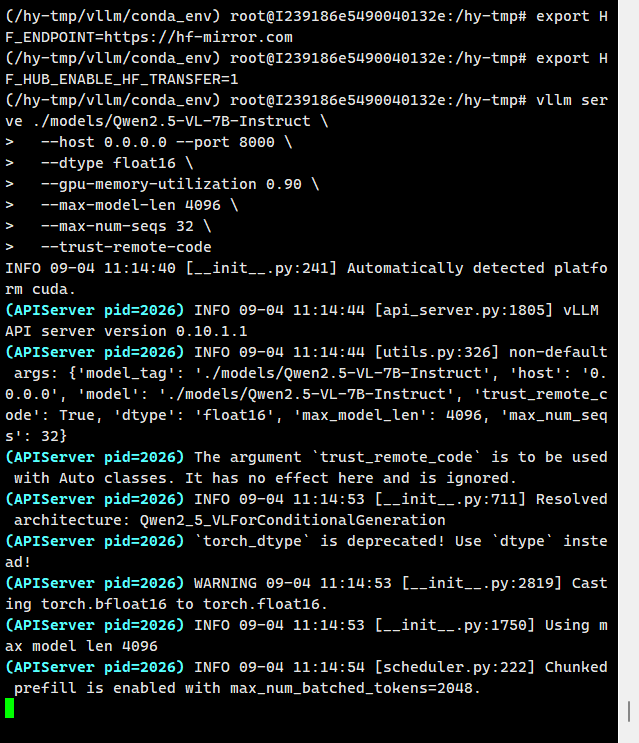
八、测试
curl -X POST http://localhost:8000/v1/chat/completions \ -H 'Content-Type: application/json' \ -d '{"model": "./models/Qwen2.5-VL-7B-Instruct", "messages": [{"role": "user", "content": "请介绍一下你是什么大模型?"}], "max_tokens": 200}'
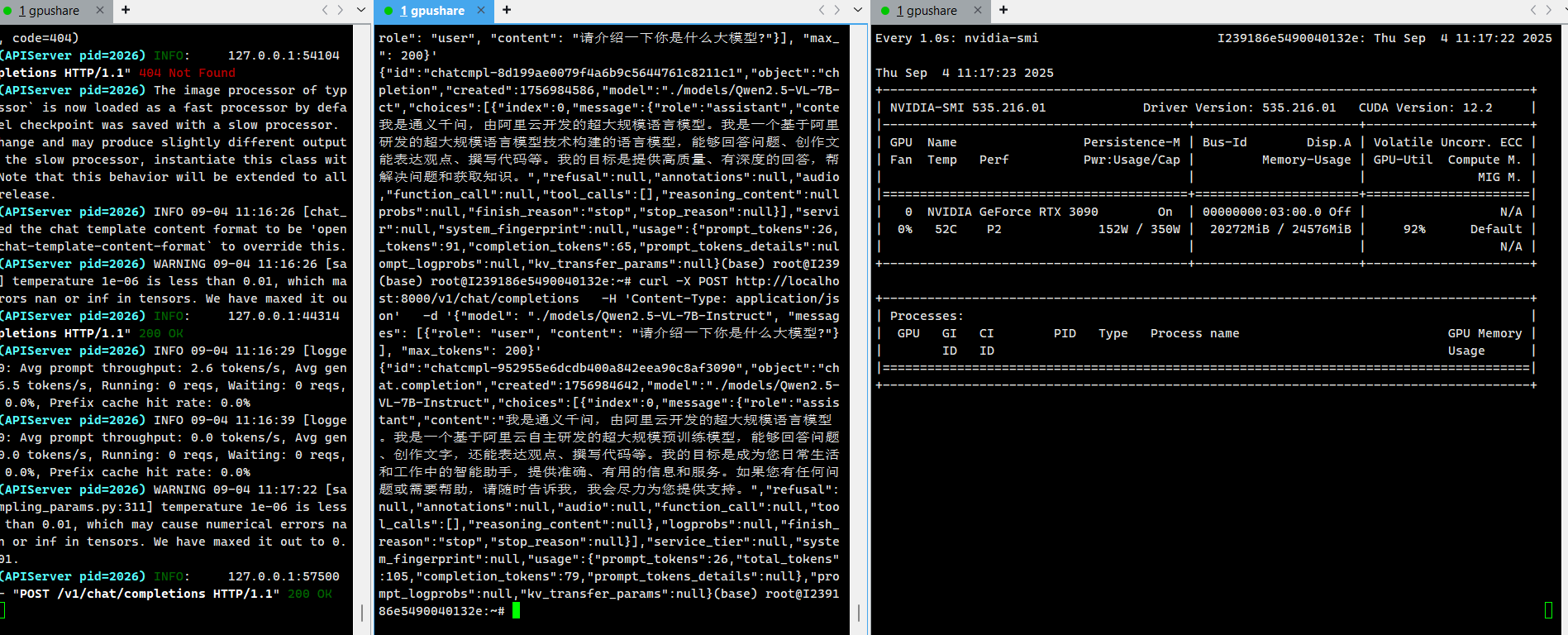
九、使用该模型进行图片理解的示例

#!/usr/bin/env python3 """ 简化的Qwen2.5-VL OCR测试脚本 专门用于测试指定图片的文字识别 """ import requests import base64 import json def test_image_ocr(): """测试图片OCR识别""" # 配置 base_url = "http://localhost:8000" model_id = "./models/Qwen2.5-VL-7B-Instruct" image_url = "https://imgb14.photophoto.cn/20200619/huaweichangxiang10plus-37734981_3.jpg" print("=== Qwen2.5-VL 图片文字识别测试 ===") print(f"图片URL: {image_url}") print(f"模型ID: {model_id}") print() try: # 1. 下载图片 print("正在下载图片...") response = requests.get(image_url, timeout=30) response.raise_for_status() # 2. 编码为base64 print("正在编码图片...") image_base64 = base64.b64encode(response.content).decode('utf-8') # 3. 构建请求 payload = { "model": model_id, "messages": [ { "role": "user", "content": [ { "type": "text", "text": "请问该图片是什么产品,同时请识别图片中的所有文字内容。" }, { "type": "image_url", "image_url": { "url": f"data:image/jpeg;base64,{image_base64}" } } ] } ], "max_tokens": 1000, "temperature": 0.1 } # 4. 发送请求 print("正在识别图片中的文字...") response = requests.post( f"{base_url}/v1/chat/completions", json=payload, timeout=60 ) # 5. 处理响应 if response.status_code == 200: result = response.json() content = result["choices"][0]["message"]["content"] print("✅ 文字识别成功!") print("\n" + "="*60) print("识别结果:") print("="*60) print(content) print("="*60) # 保存结果到文件 with open("ocr_result.txt", "w", encoding="utf-8") as f: f.write(f"图片URL: {image_url}\n") f.write(f"识别时间: {response.headers.get('Date', 'Unknown')}\n") f.write(f"识别结果:\n{content}\n") print(f"\n✅ 结果已保存到: ocr_result.txt") else: print(f"❌ 识别失败: HTTP {response.status_code}") print(f"错误信息: {response.text}") except requests.exceptions.RequestException as e: print(f"❌ 网络请求失败: {e}") except Exception as e: print(f"❌ 识别过程出错: {e}") if __name__ == "__main__": test_image_ocr()
执行结果:
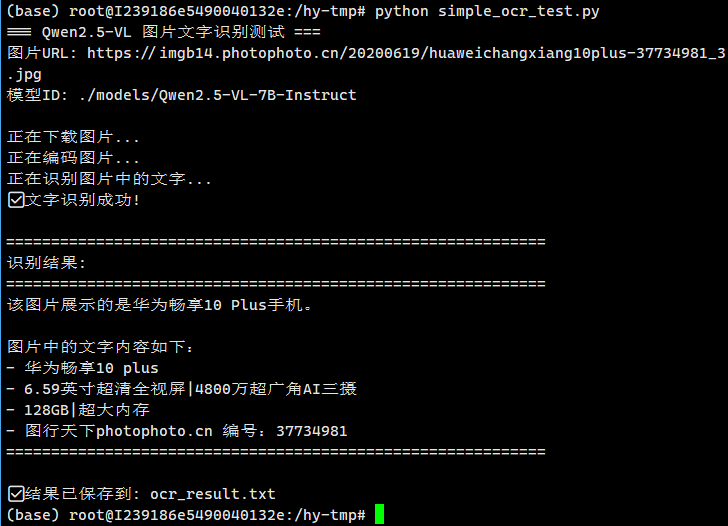
十、用完记得关机,否则会持续扣费。
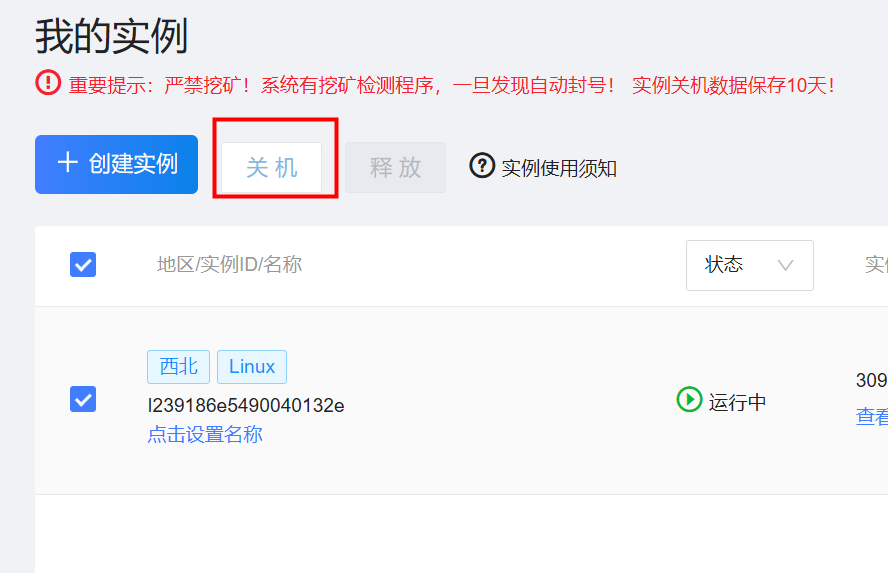
十一、备份
sudo apt-get install nano
备份脚本
#!/bin/bash set -e cd / file="hytmp-$(date "+%Y%m%d-%H%M%S").zip" zip -q -r "${file}" hy-tmp oss cp "${file}" oss://backup/ rm -f "${file}" shutdown





 浙公网安备 33010602011771号
浙公网安备 33010602011771号